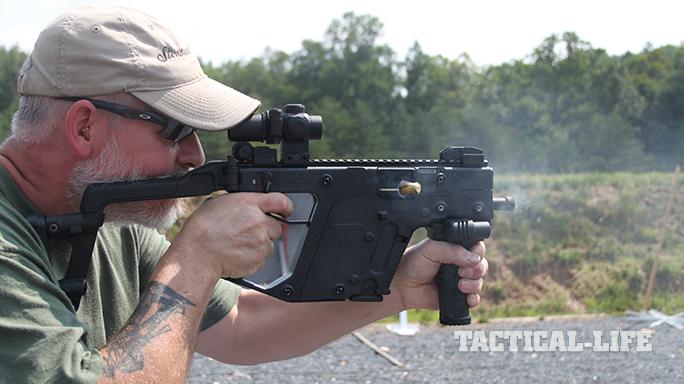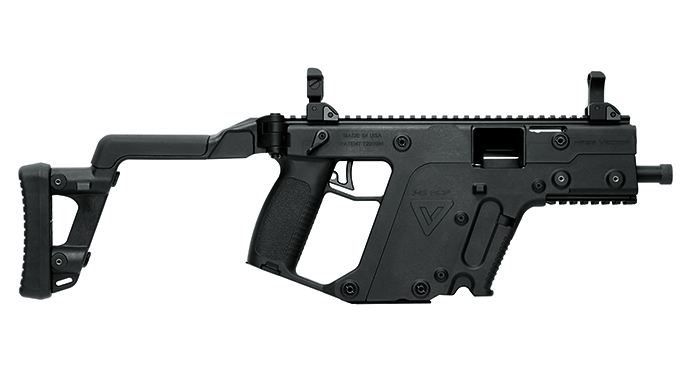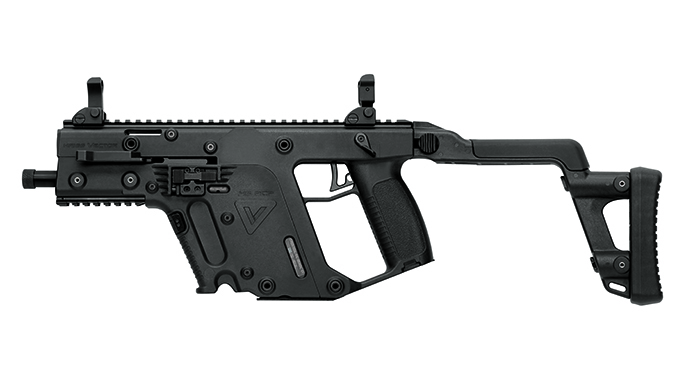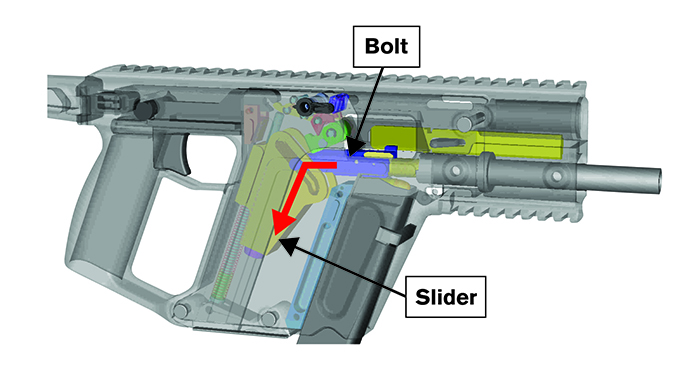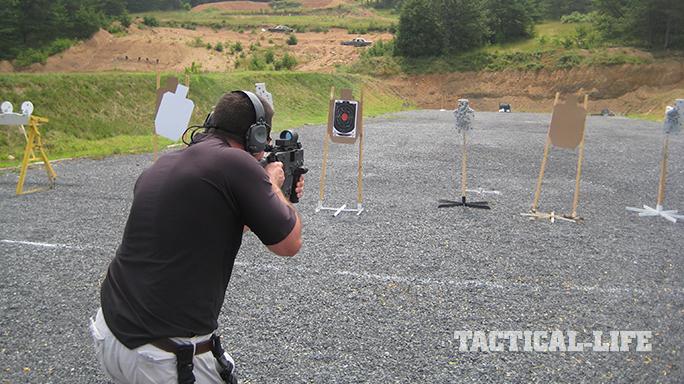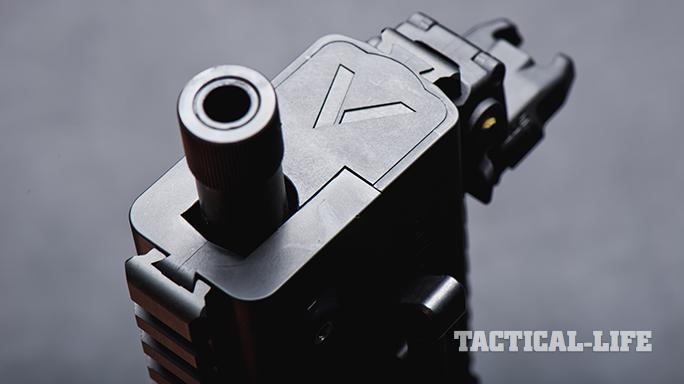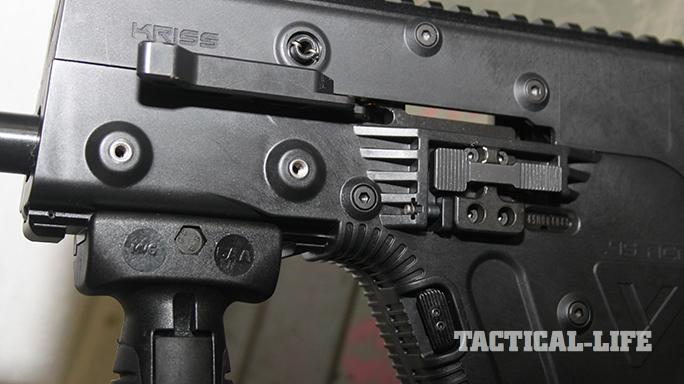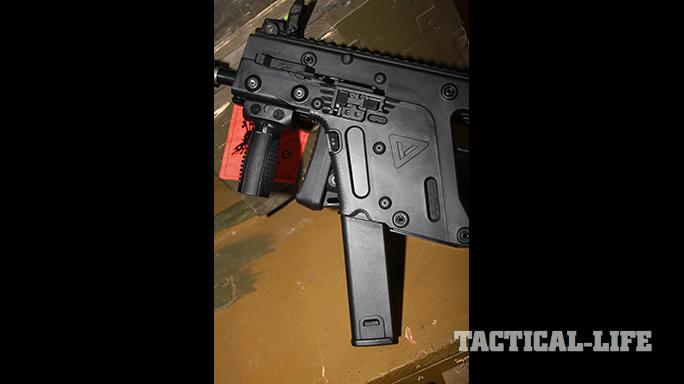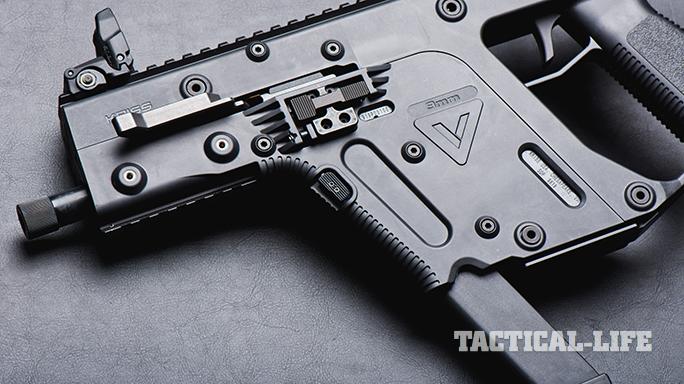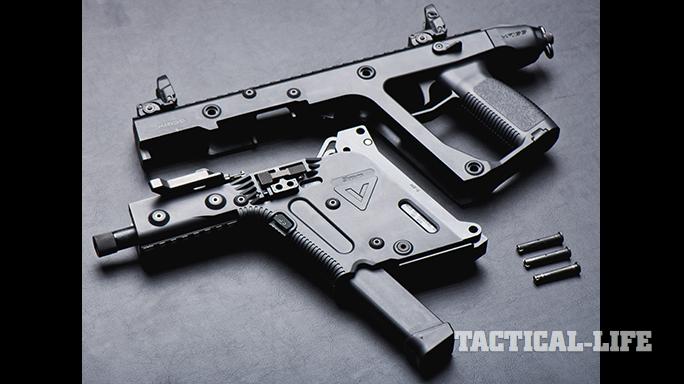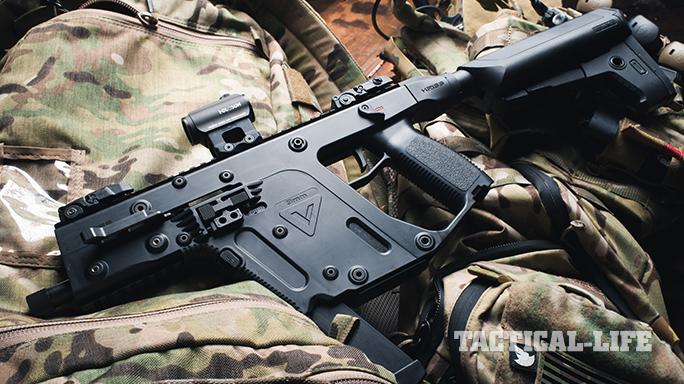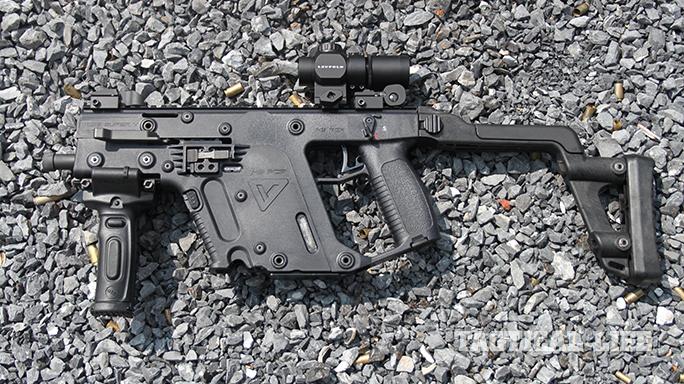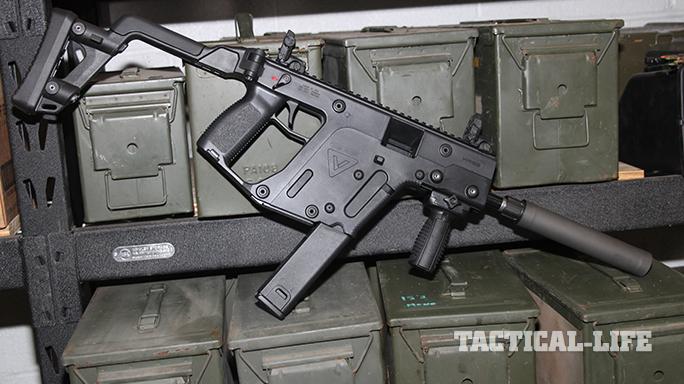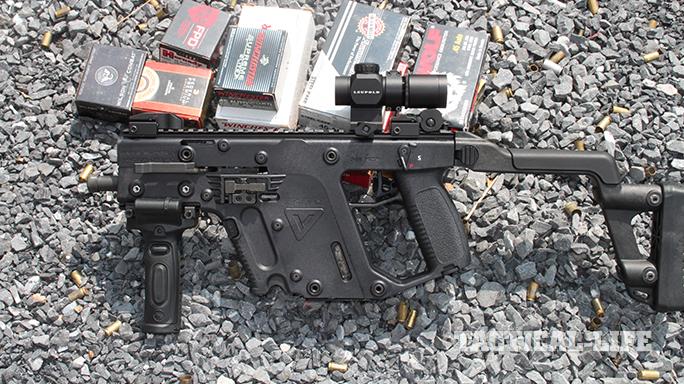When the KRISS Vector submachine gun erupted onto the firearm scene in 2006, it was heralded as “the most significant advance in weapons operating systems in over 120 years” by its developers. Media coverage, including numerous TV shows, publications and trade conventions, quickly made the KRISS Vector one of the most recognizable firearms in the world.
Of course, all of this would mean nothing if it did not perform better than previous submachine guns. When you strip away its space-age aesthetics, materials, design innovations and raving press releases, you are left with a .45 ACP submachine gun intended to put rounds on target in a hostile environment. While a select-fire submachine gun is the ultimate form of the KRISS Vector design endeavor, I recently got the chance to test the next best thing—the semi-automatic KRISS Vector SBR.
Super V Platform
The KRISS Vector’s effectiveness is centered (literally) around the patented Super V mechanism. The heart of the platform, and what sets it apart from previous submachine guns, is the delayed-blowback, closed-bolt firing system that redirects recoil forces downward. Traditional automatics have the bolt impacting a buffer or spring, transferring recoil straight back against the weapon’s frame and the shooter’s shoulder. This traditional recoil impulse and resultant muzzle climb negatively affect the sight picture and the operator’s ability to place multiple rounds on target accurately.
Advertisement — Continue Reading Below
In the Vector, the recoil generated by firing is transferred and absorbed by the Super V’s sliding mass, which dampens recoil downward and away for shooter’s shoulder. KRISS engineers emphasized as small and lightweight a bolt as possible for the Vector, and got the weight down to one-fifth the weight of your typical 1911 slide. Company literature points out that “smaller, lighter, and less travel means less recoil energy to manage.” To that end, the bolt only travels a distance equal to a loaded .45 ACP round. Early KRISS press releases point to testing by the U.S. Army Picatinny Arsenal measuring “X,” “Y,” and “Z” moments of inertia during firing. The .45 ACP KRISS Vector produced 90-percent less muzzle climb and 60-percent less felt recoil than a 9mm HK MP5—the poster child of this class.
The KRISS Vector SBR weighs 7 pounds unloaded and measures 25 inches long with the folding stock deployed and 16 inches with the stock folded. The 5.5-inch barrel gives nothing away in terms of .45 ACP ballistics, as powders used in these cartridges are tailored for handguns anyway. One of the advantages derived from the Vector SBR is increased accuracy compared to any pistol. This is rooted in the multiple points of contact when interfaced with the shooter. Your shoulder, cheek and hands are spread farther apart for greater stability over handling a handgun. This accuracy-inducing advantage is further accentuated by the Vector’s mitigated recoil, thanks to the Super V system and minimal muzzle blast.
Vector Partners
The old standard touting the advantage of having both a carbine and handgun chambered in the same caliber should not be casually dismissed. This is taken a step further with the Vector’s utilization of Glock 21 magazines. An ideal companion handgun for use with the Vector is a G21 or G41. The only thing better than using the same cartridge is feeding from the same magazines.
Advertisement — Continue Reading Below
To that end, I ran the Vector SBR with my Glock 21. But this brings us to KRISS’ G25 MagEx, a 12-round extension for the G21’s standard 13-round magazine, bumping the total capacity up to a more fitting 25 rounds. This is especially useful when using a select-fire version of the Vector, with its 1,100 rpm cyclic rate. The magazine extension has an inner and outer sleeve made of a composite material, and no special tools are required to convert a G21 magazine to a 25-rounder.
To evaluate the Vector SBR and G21 together at the range, I used a Low Profile System (LPS) belt rig from High Threat Concealment (HTC). The LPS is an adaptation of the patrol belt concept that can be concealed under a light jacket or covering garment. According to HTC literature, the LPS is tailored to those assigned to dignitary/executive protection details. HTC utilizes the latest in compression molding, vacuum forming and injection molding combined with the highest-quality thermoplastics and mil-spec hardware to make some of the most effective, low-profile tactical gear available today, and the LPS certainly left me impressed.
Many turn to the KRISS Vector SBR for the reduced recoil and muzzle blast of the .45 ACP in lieu of the increasingly popular SBRs in 5.56mm, 6.8 SPC or 7.62mm NATO. Others point to it for the ease of suppressing the .45 ACP. The Vector’s barrel has 16x1mm threading for this purpose, and I used multiple suppressors with the SBR, including a Sig Sauer SRD45. My range time consisted of not only testing the accuracy and reliability of the KRISS with all types of ammunition, but also ensuring that the suppressor in no way compromised the established accuracy and reliability baselines.
Advertisement — Continue Reading Below
I also mounted reflex sights like the Trijicon RX30 and Leupold Prismatic on the KRISS’s Picatinny top rail during testing. The non-reciprocating charging handle on the left side remains low profile until pivoted outward to work the bolt. An effective press check can be obtained by merely lifting the charging handle, which slightly retracts the bolt from the chamber, exposing the loaded round. The ambidextrous safety is ergonomically placed for either the user’s thumb or index finger to manipulate.
One final accessory seemed worthy of inclusion: the Crimson Trace MVF-515 light/laser vertical foregrip. The MVF-515 represents multitasking at its best, combining a sighting laser and high-intensity tactical light with a vertical forward grip in one package.
Range Shootout
I used an assortment of both premium self-defense JHPs and FMJs to run the KRISS and Glock together, including loads from Federal, Hornady, Sig Sauer and Winchester. The shooting commenced at a relatively steady pace, as friends of mine helped ne run the Vector through its paces on plate racks, dueling trees and other targets over some drills.
Advertisement — Continue Reading Below
The KRISS had no issue digesting JHPs whatsoever. This is important because law enforcement agencies might use expanding ammunition to limit overpenetration in CQB situations while increasing terminal effectiveness. Drills around barricades and moving through doorways allowed the KRISS Vector SBR to really shine. Numerous range evaluators, including myself, were struck by how easy it was to shoot while moving. This is surely a result of the Super V mechanism managing recoil as designed, combined with the Vector’s good balance and ergonomics.
- RELATED STORY: Home Defense Bullpup – JARD’s Glock Magazine-Fed J67
KRISS offers a variety of stock options. The standard rear stock stayed rigid when opened and pressed tightly to the shooter’s shoulder. A simple hook affixes the stock to the side of the Vector when folded. Also, the folding sights that came installed on the Vector permitted me to make headshots out to 35 yards, with center-mass aiming to get hits at 100 yards and beyond. Paper targets, plate racks and steel poppers at various distances were engaged, with some drills conducted behind simulated cover and with mandatory magazine changes.
KRISS guarantees that the Vector SBR will produce 1-inch groups at 25 yards, and the test gun maintained that with the Sig Sauer suppressor installed—there was no point-of-impact shift. Another pleasant surprise was the consistent point of aim no matter what weight or type of .45 ACP load was used. A 230-grain .45 ACP round is generally subsonic, so it was the obvious choice for use with a suppressor. But the Sig suppressor proved effective at taming the muzzle blast of even 185-grain rounds. Every load could be comfortably fired without the use of ear protection with the Sig suppressor installed. Continuing the complementary theme of the KRISS and Glock in concert, the G21 was fitted with a threaded barrel from Lone Wolf Distributors that allowed it to operate with the same Sig suppressor.
Advertisement — Continue Reading Below
Sealed With A Kriss
The KRISS Vector SBR proved accurate and durable during testing at the Echo Valley Training Center, with nearly 700 rounds fired over multiple range visits. The Vector definitely delivers on KRISS’ promises of reduced recoil and muzzle climb.
It’ll be interesting to see if the Vector is widely accepted and adopted by law enforcement and military units in the coming years as their older weapons are phased out. The platform’s ability to interact so well with .45 ACP Glocks has to be viewed favorably, with so many departments already issuing G21 or G41 handguns to their personnel. This will no doubt also influence citizens who already own Glock weapons, too. Time is on the Vector’s side, and it’s already racking up an impressive score in the reliability column.
KRISS Vector Gen II SBR Specs
| Caliber: .45 ACP |
| Barrel: 5.5 inches |
| OA Length: 16-25 inches (collapsed) |
| Weight: 7 pounds (empty) |
| Stock: Folding |
| Sights: Flip-up front and rear |
| Action: Blowback-operated semi-auto |
| Finish: Matte black |
| Capacity: 13+1 |
| MSRP: $1,569 |
This article was originally published in “Tactical Weapons” November/December 2017. To order a copy and subscribe, visit outdoorgroupstore.com.
Advertisement — Continue Reading Below
